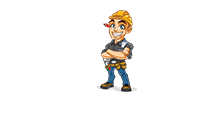.
The accident data presented in this section are predominantly gathered from the Marine Accident Investigation Branch (MAIB). The MAIB is a totally independent unit within the Department of the Environment Transport and the Regions (DETR) and reports directly to theSecretary of State. The MAIB received 1,418 accident and incident reports in 1999.Accidents to ships accounted for 641 of those reports.
The data presented here is collected from 1992 to 1999 and reflects all the reported incidents and accidents relating to fishing vessels. It is thought that the actual accident andincident figures are higher than what is presented here, as many accidents are not reported to the coastguard authorities.
Figure 2.1 shows the total number of vessels lost (primary y-axis) and total number of vessels registered (secondary y-axis) from 1992 to 1999. These figures include all vessel sizesranging from under 12 meter to over 24 meter. From this graph, it is evident that the percentage of vessels lost increased from 1992 to 1994 and then reduced from 1994 to 1998.
From 1998 onwards, it is noted that there was a sharp increase in the percentage of vessels lost. Overall, the percentage of vessels lost was between 0.27% (minimum in 1997/98) and 0.45% (maximum in 1999) of the total registered vessels, as seen in Figure 2.2 There were approximately 7,460 UK-registered fishing vessels in 1999 (end December 1999 figure). During the year 370 accidents and incidents involving these vessels were reported to the MAIB. 33 fishing vessels were lost which at 0.45% of the total fleet represent the highest rate since 1994. Machinery damage is noted as the main contributor to the high number of accidents as seen in the pie chart of Figure 2.3.
An analysis of the data from previous years shows that machinery damage has contributed to
over 50% of all accidents. This could be attributed to several factors including poorly
maintained equipment, incorrect operation, age, lack of automation, etc. The graph in Figure
2.4 shows the number of accidents caused by machinery damage from 1994 to 1999.
Although the figures indicate a decreasing trend, the number of accidents related to this category is still high and certainly unacceptable from a safety perspective. The next highest contributor to accidents is found to be flooding and foundering followed by grounding and then collision and contact. A comparison of all accident types is made asseen in Figure 2.5. Flooding and foundering is estimated to cause almost 15% to 20% of accidents on fishing vessels.
These data are cumulated and presented as a pie chart in Figure 2.6 to reveal the contribution of each accident type for the sampling period. As revealed earlier, machinerydamage is found to be the most common cause of accidents on fishing vessels, contributing 64.4% of all accidents. Foundering and flooding (14.2%), grounding (10.2%),collision and contacts (5.7%), and fires and explosions (2.9%) follow. To determine the severity of the accidents on fishing vessels, data reflecting the accidents to vessel crew together with the number of deaths are gathered and presented in Figures 2.7 and 2.8.
These bar charts show that almost 30% of accidents to crew on vessels that are under 12 meter result in deaths and for vessels that are 12-24 meters and more than 24 meters in length, these figures are calculated to be 13% and 15%, respectively. The results indicate that vessels under 12 meters have the highest casualty rates and suffer severe consequences when an accident happens. This could be attributed to the size and stability of these vessels when sailing in bad weather conditions.
The number of under 12 meter vessels that were lost is much higher than the other vessels as seen in Figure 2.9. The trend in the number of vessels lost is difficult to determine, as it does not follow any specific mathematical rule. However, by comparing the graphs in Figures 2.1, 2.2 and 2.9, it can be concluded that from 1997, the number of vessels lost increased as the percentage of registered vessels decreased.
I’m Jerri Lily , which offers quality products such as Filter Cloth, China Spiral Fabric, and many more. Know more , please visit Forming Mesh .
Find More Construction Articles
